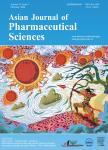Doxorubicin hydrochloride and L-arginine co-loaded nanovesicle for drug resistance reversal stimulated by near-infrared light
作者机构:Ministry of Educational(MOE)Key Laboratory of Macromolecular Synthesis and FunctionalizationDepartment of Polymer Science and EngineeringZhejiang UniversityHangzhou 310027China
出 版 物:《Asian Journal of Pharmaceutical Sciences》 (亚洲药物制剂科学(英文))
年 卷 期:2022年第17卷第6期
页 面:924-937页
核心收录:
学科分类:1007[医学-药学(可授医学、理学学位)] 1002[医学-临床医学] 100214[医学-肿瘤学] 10[医学]
基 金:financially supported by the National Natural Science Foundation of China(81673384)
主 题:Nitric oxide L-arginine Doxorubicin Indocyanine green Drug resistance Nanovesicle
摘 要:Drug resistance is accountable for the inadequate outcome of chemotherapy in *** newly emerging role of nitric oxide(NO)to conquer drug resistance has been recognized as a potential ***,it remains a great challenge to realize targeted delivery as well as accurate release of NO at desired ***,we developed a PEGylated indocyanine green(m PEG-ICG)integrated nanovesicle system(PIDA)to simultaneously load doxorubicin hydrochloride(DOX·HCl)and the NO donor L-arginine(L-Arg),which can produce NO triggered by NIR light irradiation and exert multimodal therapy to sensitize drug-resistant *** 808 nm irradiation,the NO released from PIDA led to a decrease in mitochondrial membrane potential,an increase in ROS and significant ATP depletion in K562/ADR cells,thus inhibiting cell growth and resolving the problem of drug ***,the in vivo experiment on K562/ADR-bearing nude mice indicated that PIDA nanovesicles achieved significant anticancer efficacy with a tumor inhibition rate of 80.8%.Above all,PIDA nanovesicles offer guidance for designing nanoplatforms for drug-resistant cancer treatment.



